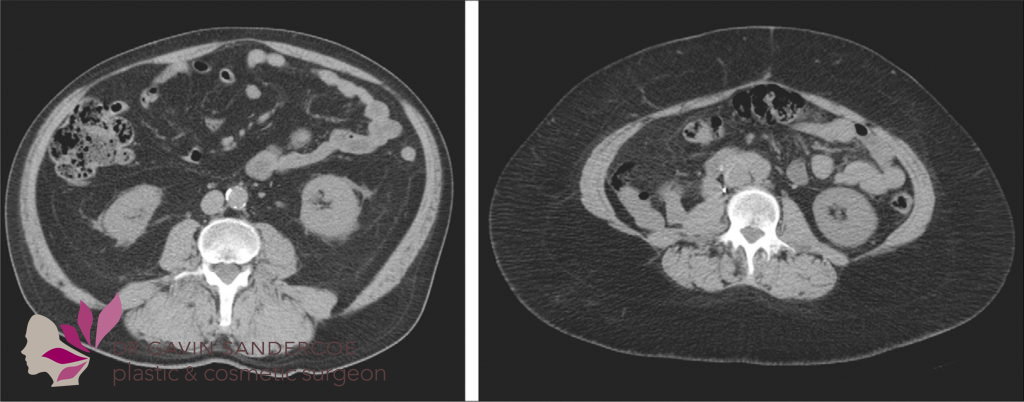Dr Gavin Sandercoe
Intra-abdominal fat in Abdominoplasty Sydney
What is intra-abdominal or visceral fat in abdominoplasty or tummy tuck in Sydney?
Patients seeking a tummy tuck or abdominoplasty in Sydney may have heard of intra-abdominal (or visceral) fat. Understanding what intra abdominal fat is, and the impact it has on your abdominal shape, will help you understand your limitations when considering an abdominoplasty.
Fat is all around our bodies – it is important in providing slide for nerves and arteries to move as you move your limbs, it is important in providing padding in your hands and feet. Most of us think of fat as the pudgy stuff that expands when we eat poorly or do not exercise enough. As we all know, weight gain can cause fat expansion at all points around your body.
Patients seeking an abdominoplasty or tummy tuck in Sydney usually want to reduce and shape the fat layer between their abdominal muscles and their skin. However, it is the fat around your abdominal organs under your abdominal muscles (intra-abdominal fat) that has the greatest impact on your abdominal shape.
Consider two patients that are both overweight.

Patient A has almost no extra-abdominal fat. They are carrying their extra weight under the muscles and around their organs (visceral or intra-abdominal fat). That extra fat under the muscles creates a ball like effect that cannot be tightened and cannot be surgically removed.
Patient B has minimal intra-abdominal fat, and is carrying their extra fat between the muscles and skin. The laxity in their abdominal wall will allow a tight abdominal muscle repair, and the extra-abdominal fat can be reduced through direct excision and liposuction.
Although Patient A could have a tummy tuck, their final result will not be as flat as Patient B.

How do I tell if I am Patient A or Patient B?
During a physical assessment for an abdominoplasty, Sydney Specialist Plastic Surgeon Dr Gavin Sandercoe will start with an abdominal examination that includes a cross-table shape assessment. Patients that are carrying extra intra-abdominal fat have a round cross sectional shape when viewed across the examination table, whilst patients that have little visceral fat will have a concave or hollow cross table shape.

Some weight loss patients will have lost most of their visceral fat despite having substantial subcutaneous fat layers. These patients still have a hollow cross table appearance, and their extra-abdominal fat spills off to the sides when they lie flat.

We see the occasional patient that is a normal weight (or BMI) but still has a round cross table shape. These patients are the most limited in their results. They are carrying little subcutaneous fat, so can’t have fat resection or liposuction without risking contour deformities. Losing visceral fat stores is important for these patients to get the results that they are often expecting.

How do I get the best result from my abdominoplasty?
The best method to improve your abdominoplasty result is to lose your intra-abdominal or visceral fat before seeking surgery. It is not always the first place that shrinks, but there are often substantial changes within the first 5-10kg of weight loss. There is some evidence that visceral fat shrinks faster than subcutaneous fat when people adopt a low carbohydrate diet. There are many hormonal influences on weight gain & loss, but using more calories than you eat (exercise) is a good place to accelerate weight loss if you have eliminated excess calories in your diet. Dr Gavin Sandercoe can refer you to several doctors & dieticians that can assist with weight loss strategies.
Patient Education Library


This website contains information about cosmetic and plastic surgery procedures and is intended for persons 18 years of age or older.


